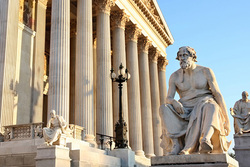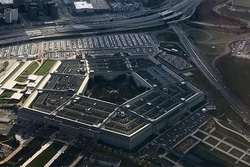One of the highest levels of statecraft is grand strategy. As long as there has been conflict between groups of people, strategy on the battlefield has been instrumental for victory, but we also know civilians are frequently asked to make certain sacrifices “for the cause” or for the “war effort.” But how do governments decide what should be asked of civilians and military personnel alike? And how will the sacrifices at home help the troops on the frontlines be successful? These are questions every practitioner of grand strategy must consider before cementing a policy decision. What is grand strategy and why does it matter to modern politics? That is what we’re exploring in this blog.
What is Grand Strategy?

How do states prioritize and mobilize which military, diplomatic, political, economic, and other sources of power to ensure their interests—whether those interests are ensuring its own survival or establishing itself as a global power? The answer is grand strategy. The word “grand,” though, has a tendency to confuse people—leading them to think it refers to ambitious, expansive goals. However, this is not the case; rather, it is an outline for how the state will manage all its resources as a means toward its ends.
The concept of “grand strategy” originally made its home in the military realm to define what is necessary for a successful military force in both wartime and peacetime. During peacetime, grand strategy continues to be important—namely, how the state can retain peace—through deterrence and coercion. Other devices within grand strategy include alliance-building, diplomacy, economic policies, intelligence, and propaganda.
Grand strategy is an expansion of traditional strategy in three key ways:
-
Inclusion of nonmilitary means including diplomatic, economic, and informational means,
-
Examination of internal policies necessary (conscription, for example), and
-
Considerations for peacetime as well as wartime.
In sum, after a state identifies what goals it has, from a policy perspective, everything that the state does to achieve those goals should be in service to meeting those goals. Every policy the state enacts should be part of and in service to the grand strategy.
History of Grand Strategy

Conceptually, grand strategy has been around for as long as there has been conflict, but it’s believed that it didn’t become well-formed until Thucydides wrote his “History of the Peloponnesian War,” in which he outlined the grand strategies of both Athens and Sparta from 412 to 404 BCE. Then, in the Roman Empire, an infrastructure of walls (such as Hadrian’s), fortresses, and roads were crucial to the Empire’s grand strategy since they made logistics much easier; this allowed the Romans to outlast their opponents on the battlefield.
For more modern examples, let’s look at the World Wars. In the First World War, Churchill’s two goals were to defeat Germany and avoid unnecessary carnage. The grand strategy in service to these goals was to attack the German periphery and open a new front in distant theaters to spread the German lines thin. During World War II, the Allies’ strategy in the Western European Theater was to again focus on Germany, since it was the strongest of the Axis and posed a direct threat to the UK and the USSR.
Then, during the Cold War, the US and the UK both used a grand strategy of “containment.” Namely, NATO countries were seeking to contain and prevent the spread of communism. This strategy endured because every US President from Harry Truman to Ronald Reagan adhered to this vision of global affairs. After the Cold War ended, Presidents Clinton, Bush, and Obama all embraced a grand strategy of liberal internationalism—which, in contrast to containment, seeks to enforce and/or spread liberal values of individual rights and free trade.
Why Study Grand Strategy?
Peter Feaver, professor of political science and public policy at Duke University, outlined it well when he described how grand strategy marries other areas of study together. He says grand strategy combines history, political science, public policy, and economics. Why are students drawn to studying grand strategy? Feaver continues, “it makes history more relevant, political science more concrete, public policy more broadly contextualized, and economics more security-oriented.”
As an international security program, the Notre Dame International Security Center specializes in teaching students every aspect of international relations including grand strategy. If you want to know more about the education NDISC provides, contact us! We have the faculty and educational opportunities to teach students at all points of their academic journey.
Originally published by at ndisc.nd.edu on July 05, 2022.